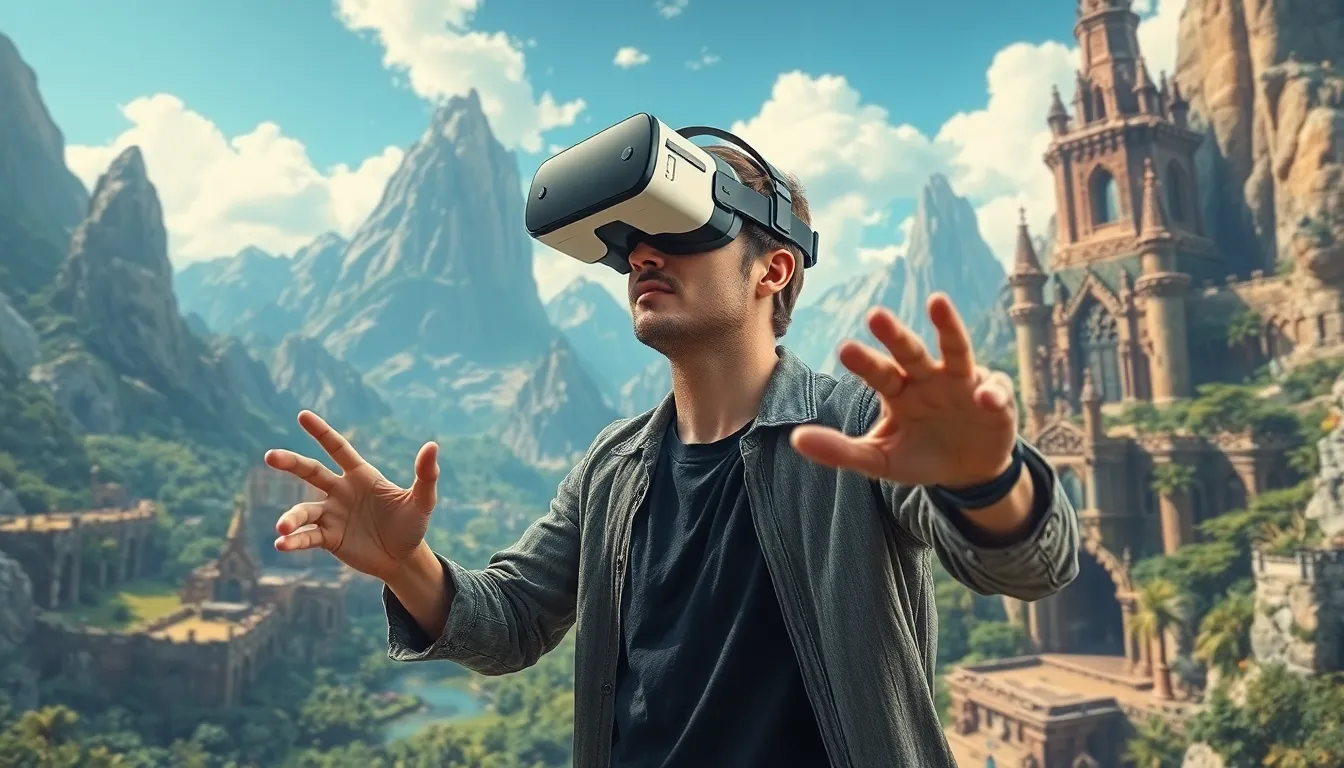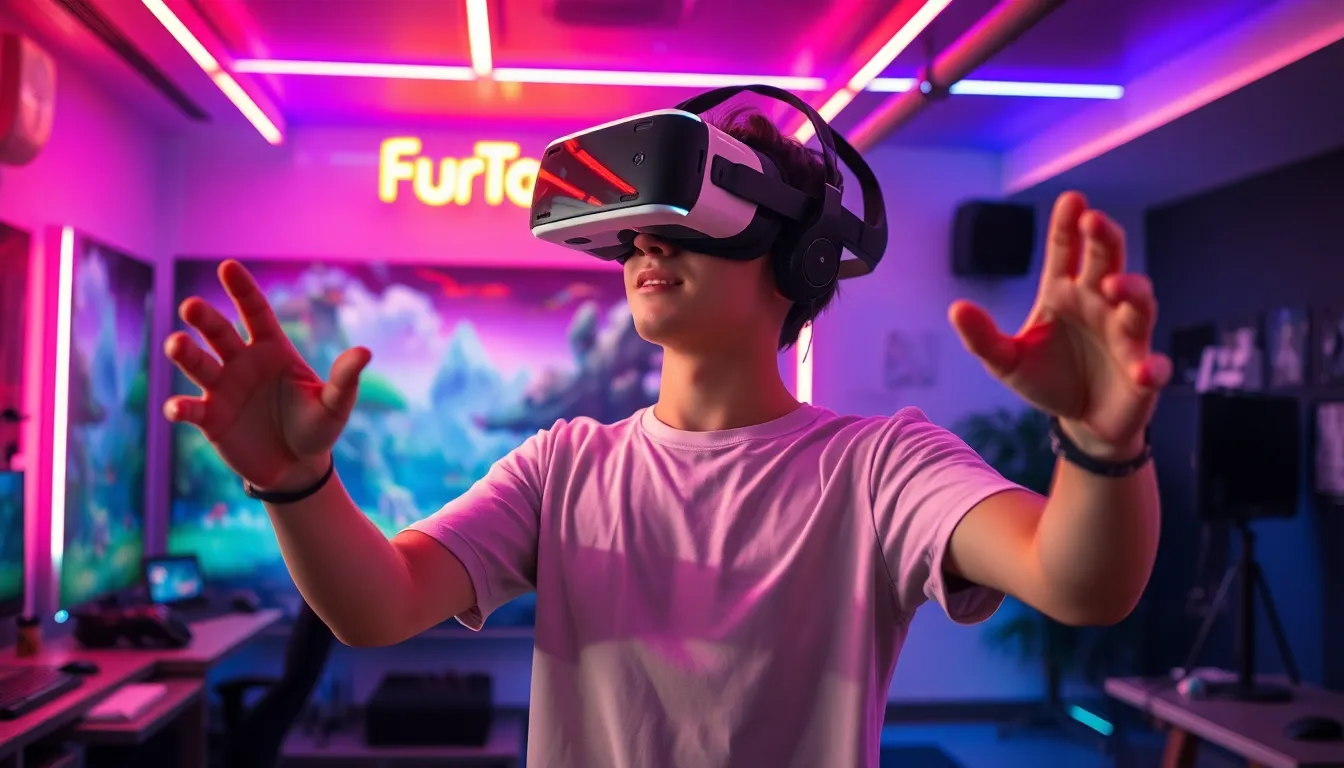Imagine stepping into a world where dragons soar overhead and your sword is only a flick of the wrist away. Welcome to the exhilarating realm of VR RPGs, where fantasy meets reality in a way that makes even the most seasoned couch potato consider a workout. With immersive visuals and interactive storytelling, these games don’t just let players escape—they pull them into a whole new universe.
Table of Contents
ToggleOverview of VR RPG
Virtual reality role-playing games (VR RPGs) merge captivating fantasy elements with immersive, lifelike experiences. These games demand player engagement, encouraging exploration and interaction within their detailed virtual worlds.
Definition and Importance
VR RPGs allow players to assume roles in expansive fictional realms. Immersion represents a key aspect, as players not only observe but actively participate in the narrative. These games foster social interaction, enabling users to collaborate with others in quests and battles. Player choice significantly shapes the game’s outcome, making decisions impactful. Additionally, VR RPGs provide an innovative platform for storytelling, enticing both seasoned gamers and newcomers.
Evolution of VR RPG
The evolution of VR RPGs traces back to early text-based adventures, gradually transitioning to graphical representations. With technological advancements, graphics and sound quality have dramatically improved. The introduction of affordable VR headsets in the early 2020s opened new avenues for immersion. Now, developers prioritize user experience, integrating hand tracking and body movement to enhance gameplay. Innovations in interactive storytelling empower players, allowing greater agency in the direction of the narrative. This ongoing evolution boosts the genre’s popularity among diverse player demographics.
Key Features of VR RPG

VR RPGs stand out due to their immersive features that enhance the player’s experience in virtual worlds. The richness of these games offers captivating elements that keep players engaged.
Immersive Environments
Immersive environments transport players into stunning worlds where every detail matters. Lifelike graphics and sound design create a sense of presence, making players feel as if they are truly part of the game. Natural landscapes, bustling cities, and intricate dungeons enhance exploration and adventure. Dynamic weather patterns and day-night cycles contribute to realism, affecting gameplay and player interactions. Players often discover hidden secrets in these detailed settings, encouraging thorough exploration. The ability to interact with various objects within these worlds adds depth to the experience, inviting curiosity and discovery.
Interactive Gameplay Mechanics
Interactive gameplay mechanics significantly elevate player engagement in VR RPGs. Real-time decision-making influences the game’s narrative and outcomes, ensuring each choice carries weight. Intuitive controls allow for gestures and movements that mimic real-life actions, fostering immersion. Puzzle-solving, combat, and crafting systems encourage players to think creatively and strategically. Multiplayer features enable collaboration, allowing players to team up for quests and challenges. Character customization options enhance personal connection to avatars, ensuring unique experiences tailored to individual preferences. Engaging with NPCs through voice recognition adds another layer of interactivity, making the virtual world feel alive and reactive.
Popular VR RPG Titles
Several VR RPGs stand out in the gaming landscape, showcasing immersive storytelling and dynamic gameplay. These titles captivate players with rich worlds and engaging mechanics.
Game 1: Overview and Features
Population: One offers a unique battle royale experience combined with RPG elements. Players engage in teamwork, strategizing to conquer opponents in a vast open environment. Dynamic vertical gameplay encourages exploration, allowing players to climb structures and glide across the map. Customization options let users tailor their characters to fit strategies, enhancing personal engagement. Interactive elements like weapon crafting and resource gathering deepen the gameplay experience, while the multiplayer setting fosters strong social connections. Players can explore diverse locales, each with distinct challenges, making every match feel fresh.
Game 2: Overview and Features
Asgard’s Wrath immerses players in Norse mythology, intertwining action and role-playing elements. Exploration is key, as players traverse beautifully crafted worlds filled with secrets and lore. Combat mechanics engage players, enabling them to wield powerful weapons and summon divine creatures for assistance. Advanced puzzle-solving challenges further enhance gameplay, requiring players to think critically. Character progression promotes skill development, allowing players to tailor their abilities to their style. Engaging narratives connect quests to larger mythological themes, creating a rich storytelling experience that keeps players invested.
Advantages of VR RPG
VR RPGs offer unique advantages that enhance the gaming experience. Players find themselves more connected to the gameplay, leading to increased enjoyment.
Enhanced Engagement
VR RPGs foster a sense of presence rarely found in traditional gaming. Players interact with the environment naturally, including reaching for objects or physically moving within the space. Collaborative quests and multiplayer experiences increase social bonding. These immersive interactions create a deeper emotional investment in characters and storylines. Engaging gameplay mechanics, such as real-time decision-making, challenge players to think quickly and creatively. Constantly evolving challenges encourage players to stay immersed and invested, enhancing overall gameplay satisfaction.
Realistic Experience
Immersive environments transport players into fantastical realms. Lifelike graphics and sound design heighten the realism of these worlds. Dynamic weather systems and day-night cycles contribute significantly to the sense of realism. Players encounter environments that react authentically to their actions, like trees swaying or birds taking flight. Customizing characters adds a personal touch, making each avatar feel unique. Engaging with non-playable characters becomes more meaningful thanks to voice recognition technology, allowing for natural conversations within the game. These features combine to create an experience that feels not only beautiful but also responsive and alive.
Challenges in VR RPG Development
VR RPG development faces several intricate challenges that impact overall player experience and game performance.
Technical Limitations
Limitations in hardware stand as a significant barrier in VR RPG development. Many players may lack access to high-performance systems, limiting graphics quality and frame rates. Development teams encounter difficulties optimizing games for various VR devices, leading to inconsistent user experiences. Furthermore, latency issues can disrupt immersion, making even minor delays in response time feel jarring. Another aspect involves the balance between visual fidelity and performance; developers must prioritize resource allocation to create stunning environments without sacrificing responsiveness.
User Experience Challenges
User experience challenges arise from the inherent nature of virtual reality. Some players may experience motion sickness during extended gameplay, causing discomfort and reducing engagement. Complexity also increases when designing intuitive controls; developers strive to make interactions seamless without overwhelming users with options. Social interaction poses another hurdle; players might find it challenging to communicate effectively in virtual spaces. Moreover, developing engaging narrative elements that resonate with diverse audiences requires careful consideration. Balancing immersive storytelling while accounting for player agency can complicate the design process significantly.
The world of VR RPGs continues to captivate players with its blend of immersive storytelling and interactive gameplay. As technology advances, these games offer deeper experiences that engage both seasoned gamers and newcomers. The ability to explore vast virtual realms and make impactful choices enhances the emotional connection players have with their avatars and the narratives they encounter.
Despite the challenges in development, the future of VR RPGs looks promising. Innovations in hardware and software are set to improve accessibility and overall player experience. As developers push the boundaries of creativity, the genre will likely evolve, bringing even more thrilling adventures to life in the virtual space.




